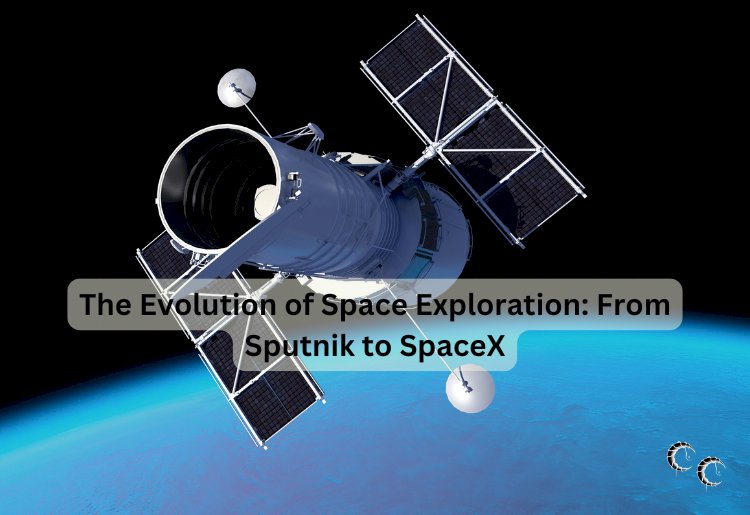The Evolution of Space Exploration: From Sputnik to SpaceX

Space exploration has been one of humanity’s most awe-inspiring endeavors, pushing the boundaries of science, technology, and human curiosity. From the early days of launching the first artificial satellites into Earth’s orbit to the private sector’s involvement in space travel, humanity’s journey to the stars has been nothing short of extraordinary.
In this article, we’ll explore the evolution of space exploration, from the launch of Sputnik to the groundbreaking achievements of SpaceX, and how these milestones have shaped the future of space travel and exploration.
The Dawn of the Space Race: The Launch of Sputnik
The story of space exploration begins in the midst of the Cold War, during a time when the United States and the Soviet Union were locked in a fierce competition for technological and ideological supremacy. On October 4, 1957, the Soviet Union launched Sputnik 1, the world’s first artificial satellite, into orbit. This event marked the beginning of the space age and sparked what would become known as the Space Race between the two superpowers.
Sputnik was a metallic sphere roughly the size of a beach ball, weighing about 184 pounds (83.6 kg). Its launch was a monumental achievement for the Soviet Union, but it also set off alarm bells in the United States. The successful launch of Sputnik meant that the Soviets had demonstrated the capability to launch missiles capable of reaching the U.S. mainland, igniting concerns over national security.
In response to the Soviet Union’s success, the United States ramped up its efforts to catch up in space exploration. The National Aeronautics and Space Administration (NASA) was created in 1958, with the goal of achieving space exploration milestones and advancing the scientific and technological understanding of space. NASA’s early years were marked by attempts to launch satellites, followed by the successful launch of its own satellite, Explorer 1, in January 1958.
The Moon Landings: A Defining Moment in Space Exploration
The space race reached its peak on July 20, 1969, when NASA’s Apollo 11 mission successfully landed humans on the Moon. The historic moment, when astronaut Neil Armstrong became the first human to step onto the lunar surface, was broadcast to millions of people around the world, solidifying the United States' victory in the Space Race.
The Apollo program, a series of space missions aimed at landing humans on the Moon and safely returning them to Earth, was the most ambitious and groundbreaking project ever undertaken by NASA. Over the course of six successful Apollo missions, twelve astronauts walked on the Moon, gathering invaluable data and samples that would expand our understanding of the lunar surface and our place in the universe.
The success of the Apollo missions was a testament to the incredible technological and engineering advancements made during the 1960s. The Apollo spacecraft, the Saturn V rocket, and the lunar modules were all feats of ingenuity that represented the cutting edge of space exploration at the time. The Moon landings were a defining moment not only for the United States but for the world, inspiring generations of scientists, engineers, and dreamers to look to the stars.
The Space Shuttle Era: Reusable Technology and Space Station Construction
After the Apollo program, the focus of space exploration shifted from lunar missions to the development of reusable spacecraft and the construction of space stations. In 1981, NASA launched the Space Shuttle program, which aimed to make space travel more affordable and accessible by using reusable spacecraft.
The Space Shuttle was designed to carry astronauts, satellites, and cargo into low Earth orbit (LEO), and it would be reused for multiple missions. The program was successful in many ways, as it allowed for regular missions to space, including the deployment and repair of satellites, the launch of the Hubble Space Telescope, and the construction of the International Space Station (ISS).
The shuttle fleet completed 135 missions between 1981 and 2011, but it was not without its challenges. The tragic Challenger disaster in 1986, in which the shuttle broke apart during launch, and the Columbia disaster in 2003, in which a shuttle disintegrated upon re-entry, were painful reminders of the inherent risks of space travel. Despite these setbacks, the Space Shuttle program was a cornerstone of human spaceflight for over three decades and laid the foundation for future space exploration endeavors.
International Collaboration and the International Space Station
As the 21st century approached, space exploration took on a more collaborative approach. The International Space Station (ISS), a joint project between NASA, Russia's Roscosmos, Japan, Canada, and the European Space Agency (ESA), was launched in 1998 and continues to serve as a platform for scientific research and international cooperation in space.
The ISS orbits Earth at an altitude of about 250 miles (400 kilometers) and serves as an important laboratory where astronauts conduct experiments in microgravity that would be impossible on Earth. The station has been inhabited continuously since November 2000, with astronauts and cosmonauts rotating in and out of the station every few months.
The ISS has not only contributed to scientific knowledge but also symbolized the growing importance of collaboration in space exploration. Countries around the world, rather than competing, have worked together to build and maintain the station, pooling resources and expertise to advance our understanding of space.
The New Frontier: The Rise of Private Space Companies
As space exploration technology matured, the cost of space missions remained prohibitively high. This reality led to a new wave of innovation in the space industry: the involvement of private companies. In the early 21st century, SpaceX, founded by entrepreneur Elon Musk in 2002, emerged as a key player in the privatization of space exploration.
SpaceX’s goal was simple but audacious: reduce the cost of space travel and make it possible for humans to travel to Mars and beyond. The company’s breakthrough came with the development of the Falcon 1, the world’s first privately developed liquid-fueled rocket to reach orbit, and the Falcon 9, a reusable rocket designed to reduce the cost of space launches.
SpaceX achieved a major milestone in 2010 when it became the first private company to send a spacecraft, Dragon, to the ISS. Since then, SpaceX has revolutionized the space industry by developing the Falcon Heavy, the most powerful operational rocket in the world, and the Starship spacecraft, which aims to transport humans to Mars.
In 2020, SpaceX achieved another historic first with the launch of the Crew Dragon spacecraft, carrying NASA astronauts to the ISS. This marked the first time a private company had sent humans into space, paving the way for the commercialization of space travel.
Beyond Earth’s orbit, SpaceX’s Starship program represents humanity’s most ambitious plan yet for interplanetary exploration, with the goal of sending humans to Mars and creating a self-sustaining colony on the Red Planet.
The Future of Space Exploration: A New Era of Discovery
As we look to the future, space exploration is poised to enter a new era of discovery, fueled by technological advancements, international collaboration, and the rise of private companies like SpaceX. The next few decades could see humans return to the Moon, establish a permanent presence on Mars, and venture into the outer reaches of the solar system with missions to the gas giants and beyond.
NASA’s Artemis program aims to return astronauts to the Moon by the mid-2020s, with the goal of establishing a sustainable human presence on the lunar surface. The James Webb Space Telescope, scheduled for launch in 2021, promises to revolutionize our understanding of the universe by exploring distant galaxies and exoplanets.
In addition to government space agencies, private companies like SpaceX, Blue Origin, and Virgin Galactic are working to make space tourism a reality. While this industry is still in its early stages, the growing accessibility of space travel promises to open up new possibilities for exploration and scientific discovery.
Conclusion: The Journey Continues
From the launch of Sputnik to the revolutionary achievements of SpaceX, the journey of space exploration has been a testament to human ingenuity, perseverance, and curiosity. As we continue to push the boundaries of what’s possible, the future of space exploration holds limitless potential. Whether it’s returning to the Moon, sending humans to Mars, or discovering new worlds beyond our own, the quest to explore the cosmos is just beginning.































